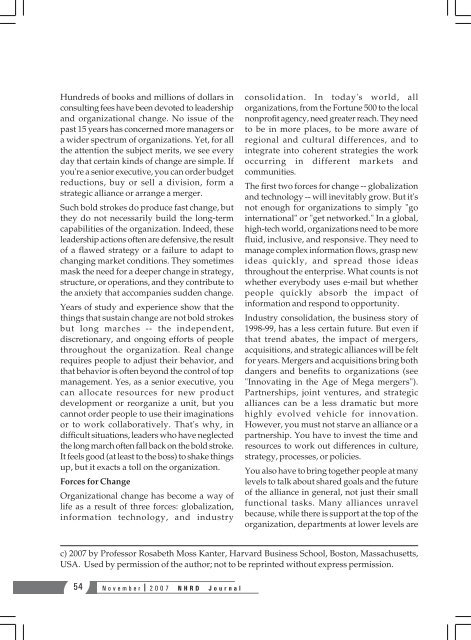NHRD Journal - National HRD Network
NHRD Journal - National HRD Network
NHRD Journal - National HRD Network
Create successful ePaper yourself
Turn your PDF publications into a flip-book with our unique Google optimized e-Paper software.
Hundreds of books and millions of dollars in<br />
consulting fees have been devoted to leadership<br />
and organizational change. No issue of the<br />
past 15 years has concerned more managers or<br />
a wider spectrum of organizations. Yet, for all<br />
the attention the subject merits, we see every<br />
day that certain kinds of change are simple. If<br />
you're a senior executive, you can order budget<br />
reductions, buy or sell a division, form a<br />
strategic alliance or arrange a merger.<br />
Such bold strokes do produce fast change, but<br />
they do not necessarily build the long-term<br />
capabilities of the organization. Indeed, these<br />
leadership actions often are defensive, the result<br />
of a flawed strategy or a failure to adapt to<br />
changing market conditions. They sometimes<br />
mask the need for a deeper change in strategy,<br />
structure, or operations, and they contribute to<br />
the anxiety that accompanies sudden change.<br />
Years of study and experience show that the<br />
things that sustain change are not bold strokes<br />
but long marches -- the independent,<br />
discretionary, and ongoing efforts of people<br />
throughout the organization. Real change<br />
requires people to adjust their behavior, and<br />
that behavior is often beyond the control of top<br />
management. Yes, as a senior executive, you<br />
can allocate resources for new product<br />
development or reorganize a unit, but you<br />
cannot order people to use their imaginations<br />
or to work collaboratively. That's why, in<br />
difficult situations, leaders who have neglected<br />
the long march often fall back on the bold stroke.<br />
It feels good (at least to the boss) to shake things<br />
up, but it exacts a toll on the organization.<br />
Forces for Change<br />
Organizational change has become a way of<br />
life as a result of three forces: globalization,<br />
information technology, and industry<br />
consolidation. In today's world, all<br />
organizations, from the Fortune 500 to the local<br />
nonprofit agency, need greater reach. They need<br />
to be in more places, to be more aware of<br />
regional and cultural differences, and to<br />
integrate into coherent strategies the work<br />
occurring in different markets and<br />
communities.<br />
The first two forces for change -- globalization<br />
and technology -- will inevitably grow. But it's<br />
not enough for organizations to simply "go<br />
international" or "get networked." In a global,<br />
high-tech world, organizations need to be more<br />
fluid, inclusive, and responsive. They need to<br />
manage complex information flows, grasp new<br />
ideas quickly, and spread those ideas<br />
throughout the enterprise. What counts is not<br />
whether everybody uses e-mail but whether<br />
people quickly absorb the impact of<br />
information and respond to opportunity.<br />
Industry consolidation, the business story of<br />
1998-99, has a less certain future. But even if<br />
that trend abates, the impact of mergers,<br />
acquisitions, and strategic alliances will be felt<br />
for years. Mergers and acquisitions bring both<br />
dangers and benefits to organizations (see<br />
"Innovating in the Age of Mega mergers").<br />
Partnerships, joint ventures, and strategic<br />
alliances can be a less dramatic but more<br />
highly evolved vehicle for innovation.<br />
However, you must not starve an alliance or a<br />
partnership. You have to invest the time and<br />
resources to work out differences in culture,<br />
strategy, processes, or policies.<br />
You also have to bring together people at many<br />
levels to talk about shared goals and the future<br />
of the alliance in general, not just their small<br />
functional tasks. Many alliances unravel<br />
because, while there is support at the top of the<br />
organization, departments at lower levels are<br />
c) 2007 by Professor Rosabeth Moss Kanter, Harvard Business School, Boston, Massachusetts,<br />
USA. Used by permission of the author; not to be reprinted without express permission.<br />
54<br />
November 2007 <strong>N<strong>HRD</strong></strong> <strong>Journal</strong>
















